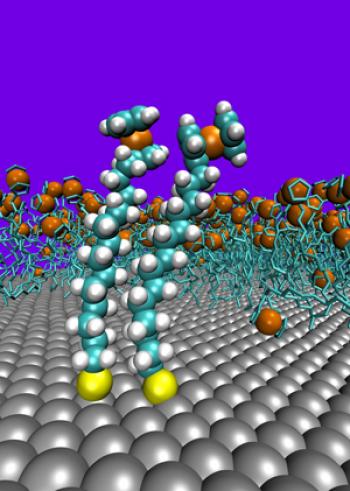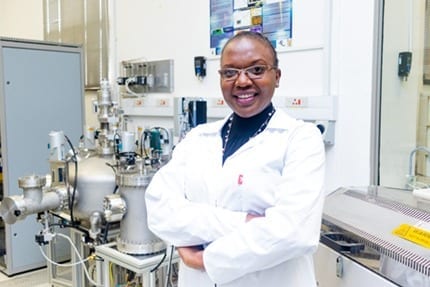
Fifty thousand of the rectifier molecules strung end to end would fit across the diameter of a human hair
A team of scientists from Tyndall National Institute at University College Cork and the National University of Singapore have designed and fabricated ultra-small devices for energy-efficient electronics. By finding out how molecules behave in these devices, a ten-fold increase in switching efficiency was obtained by changing just one carbon atom. These devices could provide new ways to combat overheating in mobile phones and laptops, and could also aid in electrical stimulation of tissue repair for wound healing. The breakthrough creation of molecular devices with highly controllable electrical properties will appear in the February issue of Nature Nanotechnology (Advance Online Publication doi:10.1038/nnano.2012.238). Dr. Damien Thompson at the Tyndall National Institute, UCC and a team of researchers at the National University of Singapore led by Prof. Chris Nijhuis designed and created the devices, which are based on molecules acting as electrical valves, or diode rectifiers.
Dr. Thompson explains “These molecules are very useful because they allow current to flow through them when switched ON and block current flow when switched OFF. The results of the study show that simply adding one extra carbon is sufficient to improve the device performance by more than a factor of ten. We are following up lots of new ideas based on these results, and we hope ultimately to create a range of new components for electronic devices.” Dr. Thompson’s atom-level computer simulations showed how molecules with an odd number of carbon atoms stand straighter than molecules with an even number of carbon atoms. This allows them to pack together more closely. Tightly-packed assemblies of these molecules were formed on metal electrode surfaces by the Nijhuis group in Singapore and were found to be remarkably free of defects. These high quality devices can suppress leakage currents and so operate efficiently and reliably. The device can be cleanly switched on and off purely on the basis of the charge and shape of the molecules, just like in the biological nanomachines that regulate photosynthesis, cell division and tissue growth.
Tyndall Electronic Theory Group leader Prof. Jim Greer explains: “Modern electronic devices such as telephones and tablets in manufacture today rely on tiny switches approaching molecular sizes. This provides new challenges for electronics but opens up exciting opportunities for blending molecular properties to be used to advantage. Dr. Thompson’s work is an exciting new avenue to exploit molecular design to achieve new ways to perform information processing.” A key enabling feature for nanoscale electronics will be the ability to use molecules as rectifiers and switches. By demonstrating the rational design of molecules that rectify current with a large and highly-reproducible ON/OFF ratio, the study provides a key advance towards the creation of technologically viable ultra-small device components. Fifty thousand of the rectifier molecules strung end to end would fit across the diameter of a human hair. Advances in computing, synthesis and characterisation means scientists can now understand and control material at the scale of atoms and molecules.
The Latest Bing News on:
Nanoscale electronics
- Georgia Tech group create world’s first graphene-based semiconductoron April 26, 2024 at 10:13 am
A group of researchers at the Georgia Institute of Technology (Georgia Tech) have created the world’s first functional semiconductor made from graphene, a development that could lead to advanced ...
- Automotive Electronicson April 23, 2024 at 5:00 pm
Recom has created a chassis-mount isolated dc-dc converter for nominal battery voltages from 24 to 90V. Called RMOD360-UW, it can deliver full power continuously with inputs between 27 and 106V, as ...
- 10 Things to Know Before You Buy Refurbished Electronicson April 21, 2024 at 5:00 pm
These tips can help you get a deal and avoid being ripped off when buying refurbished laptops, TVs, phones, and other electronics. I've been writing about computers, the internet, and technology ...
- Nanocircuitry: Miniaturizing Electronics to the Nanoscaleon April 20, 2024 at 12:50 pm
such as flexible electronics, wearable devices, and the Internet of Things (IoT), will open up new possibilities for smart and connected systems that can sense, process, and communicate information at ...
- Atom-by-atom: Imaging structural transformations in 2D materialson April 17, 2024 at 2:36 pm
Silicon-based electronics are approaching their physical limitations and new materials are needed to keep up with current technological demands. Two-dimensional (2D) materials have a rich array of ...
- Atom-by-atom: Imaging structural transformations in 2D materialson April 16, 2024 at 5:01 pm
Silicon-based electronics are approaching their physical ... in turn, affects both its nanoscale and microscopic behavior." The structure and properties of 2D multilayers are often highly ...
- Quantum electronics: Charge travels like light in bilayer grapheneon April 16, 2024 at 11:13 am
An international research team has demonstrated experimentally that electrons in naturally occurring double-layer graphene move like particles without any mass, in the same way that light travels.
- Nanoscale Movies Shed Light on One Barrier to a Clean Energy Futureon April 9, 2024 at 5:00 pm
Using nanoscale imaging techniques, Duke researchers are trying to understand why these catalysts break down and lose activity over time. Credit: Avery Vigil, Duke chemistry Part of the trouble is ...
- Tongfang Guoxin Electronicson April 3, 2024 at 5:00 pm
Tongfang Guoxin Electronics Co., Ltd. is engaged in the electronic components industry. It focuses on resonator, oscillator and capacitor. Its business scope includes manufacturing and sales of ...
- Molecular Electronics: Building Circuits at the Nanoscaleon April 3, 2024 at 2:36 pm
Molecular electronics is a branch of nanotechnology that focuses on using individual molecules or nanoscale molecular structures as electronic components to create miniaturized circuits and devices.
The Latest Google Headlines on:
Nanoscale electronics
[google_news title=”” keyword=”nanoscale electronics” num_posts=”10″ blurb_length=”0″ show_thumb=”left”] [/vc_column_text]The Latest Bing News on:
Molecular electronics
- Ruling: Iowa state auditor must provide more evidence to justify withholding emailson April 26, 2024 at 5:45 pm
The state auditor's office must do more to justify its decision to withhold from public release emails between his office and two journalists, the Iowa Supreme Court ruled.
- Clue to Aspirin, Colon Cancer Link; New Lutathera Approval; AI & Electronic Recordson April 26, 2024 at 12:51 pm
Integrating AI into electronic messaging systems may help relieve physician burden and improve patient education but still requires a "physician in the loop" as a backstop for errors in messaging. ( ...
- New circuit boards can be repeatedly recycledon April 26, 2024 at 9:19 am
A recent United Nations report found that the world generated 137 billion pounds of electronic waste in 2022, an 82% increase from 2010. Yet less than a quarter of 2022's e-waste was recycled. While ...
- Molecular electronics: what will future gadgets be like?on April 26, 2024 at 6:58 am
The discovery that won the latest Nobel Prize in physics seems far away from our life, but one day everything could change with the arrival of molecular gadgets. We've tried to look into the future.
- Researcher develop high-performance amorphous p-type oxide semiconductoron April 26, 2024 at 6:56 am
Researchers have collaborated on the development of a tellurium-selenium composite oxide semiconductor material. Their efforts led to the successful creation of a high-performance and highly stable ...
- A Test Told Me I’m Basically Made of Plastic. You Probably Are Tooon April 26, 2024 at 6:13 am
“If you have a sufficiently sensitive test, you will find these chemicals in everyone,” adds Dr. Christos Symeonides, a pediatrician and the principal researcher for plastics with the Minderoo ...
- AI Can ‘Unbias’ Healthcare—But Only If We Work Together To End Data Disparityon April 26, 2024 at 5:00 am
Let us ensure that legacy approaches and biased data do not virulently infect novel and incredibly promising technological applications in healthcare.
- More efficient molecular motor widens potential applicationson April 26, 2024 at 2:00 am
Light-driven molecular motors were first developed nearly 25 years ago at the University of Groningen, the Netherlands. This resulted in a shared Nobel Prize for Chemistry for Professor Ben Feringa in ...
- Quasi-2D spin-Peierls transition through interstitial anionic electrons in K(NH₃)₂on April 25, 2024 at 1:34 pm
In a paper published in Science Bulletin, a Chinese team of scientists predicts a novel electride K(NH3)2, with interstitial electrons distributed at cages formed by six ammonia molecules and forming ...
- Research combines DNA origami and photolithography to move one step closer to molecular computerson April 24, 2024 at 8:49 am
Molecular computer components could represent a new IT revolution and help us create cheaper, faster, smaller, and more powerful computers. Yet researchers struggle to find ways to assemble them more ...
The Latest Google Headlines on:
Molecular electronics
[google_news title=”” keyword=”molecular electronics” num_posts=”10″ blurb_length=”0″ show_thumb=”left”]








